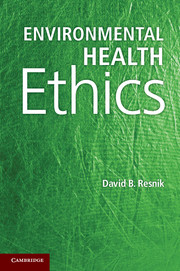Book contents
- Frontmatter
- Contents
- Figures and Tables
- Acknowledgments
- Abbreviations
- 1 Introduction
- 2 An Overview of Environmental Health
- 3 Ethical Theory
- 4 Toward an Environmental Health Ethics
- 5 Pest Control
- 6 Genetic Engineering, Food, and Nutrition
- 7 Pollution and Waste
- 8 The Built Environment
- 9 Climate Change, Energy, and Population
- 10 Justice and Environmental Health
- 11 Environmental health Research Involving Human Participants
- 12 Conclusion
- References
- Index
7 - Pollution and Waste
Published online by Cambridge University Press: 05 July 2012
- Frontmatter
- Contents
- Figures and Tables
- Acknowledgments
- Abbreviations
- 1 Introduction
- 2 An Overview of Environmental Health
- 3 Ethical Theory
- 4 Toward an Environmental Health Ethics
- 5 Pest Control
- 6 Genetic Engineering, Food, and Nutrition
- 7 Pollution and Waste
- 8 The Built Environment
- 9 Climate Change, Energy, and Population
- 10 Justice and Environmental Health
- 11 Environmental health Research Involving Human Participants
- 12 Conclusion
- References
- Index
Summary
This chapter will discuss issues related to the dispersal of pollutants and wastes into the environment. It will describe common types of pollution and waste, and how they impact human health and the environment. It will also discuss pollution issues related to nanotechnology.
AIR POLLUTION
Air pollution has caused health problems for urban populations for hundreds of years. In the 1200s, a commission established in London to deal with pollution emitted from kilns, furnaces, and fireplaces recommended restrictions on coal burning, which were largely ignored. As noted in Chapter 2, pollution from coal-burning factories and steam engines during the Industrial Revolution in nineteenth-century England did not trigger any air quality legislation. Several events in the twentieth century led many countries to adopt air pollution regulations. A severe air pollution episode killed sixty people in Meuse Valley, Belgium in 1930, and, in 1948, an industrial air pollution event killed twenty people in Sonora, Pennsylvania. In December 1952, a dense cloud of air pollution from the burning of coal to heat homes settled over London. The cloud, known as the London Fog, contained sulfur dioxide and particulate matter. During a two-week period in which sulfur dioxide levels tripled, the mortality rate tripled. It is estimated that as many as 12,000 people died as a direct result of the London Fog (Bell and Davis 2001; Bell and Samet 2010).
- Type
- Chapter
- Information
- Environmental Health Ethics , pp. 133 - 157Publisher: Cambridge University PressPrint publication year: 2012

